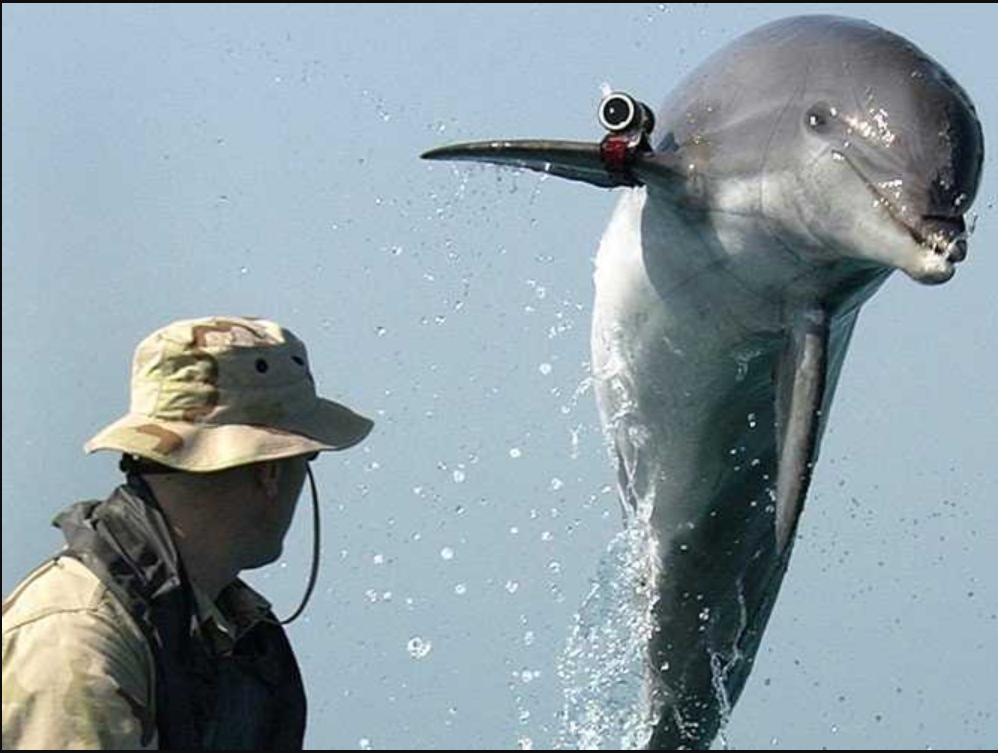 |
| Image Pinterest |
The first users of the underwater creatures for military use were ancient Greeks. They put blood into their harbors for making sharks aggressive. Also, South American Indians might use piranha fishes as weapons. If there is blood in the water. Those piranhas turn very aggressive. Romans and their successors used trained dogs on battlefields. And the most brutal version of those things were dogs infected with rabies. There are lots of people who want to end the dolphin training programs. Those animals are intelligent, easy to train, and very capable to search for dropped things from underwater areas. Those people argue that dolphins should be free.
But the protectors of those dolphin training programs are saying that dolphins and orca are like underwater dogs. Orcas are big dolphins that are capable to catch the swimmer. And throw them to the deck of the ships. But as we know the modern technology like neuro-implanted microchips and artificial intelligence that allows benefiting animal's natural communication to control them is opening new visions for using animals for military and law enforcement. The new microchips are turning things like insects into robots that can carry small surveillance devices to buildings. Those microchips can load by using ultrasonic waves. And that means even small fish can use as spy robots.
Russia is not the only state that uses trained dolphins or orcas to protect its underwater structures and naval bases. Military forces are also trained sea lions and seals along with some birds and dog-animals like wolves to patrol and guard areas.
Artificial intelligence makes it possible to translate the communication signals of animals. That thing means that operators can control dolphins and other animals by benefiting from their communication.
For controlling dogs those operators can use a series of recorded sounds. Those sounds can activate by using the computer or mobile telephone application. That command device can install on the collar along with a small action camera and microphone. Then the operator can select the right sound from the menu. Those sounds can deliver by using the frequency that is out of the human hearing area.
And the last thing in this sector is the neuro-implanted microchips. Those microchips allow controlling the behavior of any animal in the world.
Trained animals can drop surveillance equipment at the installations. Also trained dolphins can use as "guard dogs" but they can also put the location devices and even detonators on the bottom of the ships and underwater installations.
Drug police use falcons to capture carrier pigeons that carry drugs. Big birds like owls and eagles can also use to take off the snipers. Those birds are trained to locate the sniper and then attack their neck.
There are also tested things like wasps and other insects to carry miniaturized reconnaissance tools. Those insects can also use to locate mines and explosives.
If things like bees and wasps are growing with explosives they think that explosive is food. And that means they can be used to locate things like plastic explosives. For those missions to the insects can connect the miniaturized location system. The small drones can follow those insects. And if many of them will land on the same spot that tells there might be mines. Also, things like bluebottles and vultures can use to track buried bodies. Vultures can also use to track people on the streets. So they can act like flying dogs.
But those animals can also train to search for explosives. Things like rats can also train to search for explosives. Those animals must only eat plastic explosives with heroin. The rat can equip with a backpack there is a detonator. When the operator locates that rat in the ammunition storage that person can detonate that explosive when the rat is near the ammunition. And that makes them search ammunition dumps. Searching for hidden drugs is easier. Those rats must just get drugs in their nutrient and then they will equip with a GPS. That allows for locating hidden drugs.
https://citizenfreepress.com/breaking/russia-deploys-military-combat-dolphins/?msclkid=c00072a7c6b211ec87f490e5833c4c3f




No comments:
Post a Comment
Note: Only a member of this blog may post a comment.